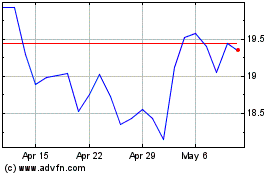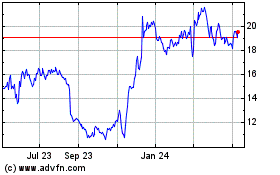By Suzanne Kapner
A few years ago, Restoration Hardware had three Denver-area
stores scattered in malls. Today, the furniture chain has just one
new one: a palatial, four-story gallery with a rooftop garden.
A few years ago, Restoration Hardware had three stores in malls
scattered around Denver. Today, the furniture chain has just one
new one: a palatial, four-story gallery with a rooftop garden.
Retailers from Gap Inc. to Abercrombie & Fitch Inc. are
abandoning a decades-old strategy of growing sales by blanketing
cities with stores as consumers do more of their shopping online
and less at the mall.
The shifting shopping habits have prompted chains such as
Williams-Sonoma Inc. and Macy's Inc. to close stores in secondary
malls to focus on web sales and more upscale shopping centers.
Restoration Hardware Holdings Inc. closed its three older
Denver-area stores and last fall opened the 70,000-square-foot
flagship at the Cherry Creek Shopping Center, an upscale mall that
also is home to Burberry and Brooks Brothers.
Restoration Hardware declined to discuss its new approach, but
its change in direction is part of a redesign of the nation's
commercial centers -- a reversal of the "malling" of America.
"With technology, retailers don't need that extra store in a
marginal market," said William Taubman, the chief operating officer
of Taubman Centers Inc., which owns Cherry Creek and mainly
operates high-end, or so-called "A" malls. That is widening the gap
between the country's most productive malls and weaker properties,
executives and analysts said.
Once-solid regional "B" malls that thrived for years are losing
shoppers and tenants to the "A" malls -- those with sales per
square foot in excess of $500, according to Green Street
Advisors.
The research firm estimates that about 44% of total U.S. mall
value, which is based on sales, size and quality among other
measures, resides with the top 100 properties, out of about 1,000
malls.
Almost all of the 40 stores that Macy's closed last year were in
"B" or "C" malls, according to Green Street. For already weak
malls, the loss of an anchor can accelerate a downward spiral that
leads to other vacancies.
Not all "B" malls are struggling, however.
"If they are the only game in town, they are less at risk," said
DJ Busch, a senior analyst at Green Street. What undermines them is
when a better mall opens nearby. That was the case when The Mall at
University Town Center opened in Sarasota, Fla., in 2014, and
pulled a number of tenants out of nearby Westfield Southgate mall,
including Williams-Sonoma, Dillard's and Saks Fifth Avenue.
Mall owners disagree about whether the Internet is their main
problem. They point to demographic changes that redirected
population and income growth away from malls built years ago, along
with a real estate glut that has left the U.S. with 24 square feet
of retail space per person, compared with 15 for Canada, 10 for
Australia and 5 for the U.K., according to the International
Council of Shopping Centers.
They also note that e-commerce amounted to just 7.5% of total
fourth-quarter retail sales, according to the U.S. Census Bureau.
But if you strip out grocery, home improvement and other items you
typically can't buy at a mall, says Mr. Busch, e-commerce is closer
to 20% of mall sales.
Many of the top malls are attracting higher end tenants and
leasing space to upscale restaurants and gyms, or hosting events.
As a result, shoppers are more apt to bypass smaller, local malls
that tend to stock basic items more easily purchased online.
Kelly Woyan-Rudnicki, a writer and movie producer who lives in
San Clemente, Calif., said she prefers to drive 30 miles to South
Coast Plaza in Costa Mesa, rather than shop at her local mall. In
addition to a wide range of stores, from Chanel to Uniqlo, the mall
boasts 40 restaurants and coffee shops, and hosts events such as
fashion shows and book signings.
"It's the whole immersive experience," she said.
That is paying off for retailers like Restoration Hardware. CEO
Gary Friedman told analysts in March, that sales were two-to-four
times higher in markets where it had switched to giant stores. "We
are very early into the transformation of our real estate," he
said. "All of our next-generation design galleries are exceeding
plan."
Taubman's tenants averaged sales-per-square-foot of $800 last
year, up 57% since 2005. That compares with CBL & Associates
Properties Inc., which operates "B" and "C" malls. Its
sales-per-square-foot rose just 13% to $374 during that period.
CBL Chief Executive Stephen Lebovitz said his company's
middle-market malls haven't benefited as much from the recent boom
in luxury sales, but weren't hurt as much during the recession. As
a result, their sales growth has been slower, but more even.
Large mall operators have been divesting lower-performing
properties to double down on their most profitable locations. Both
Simon Property Group Inc. and General Growth Properties Inc. have
spun off lower-quality malls into separate companies so they can
focus their capital on higher end properties.
During the past decade, Westfield Corp. has sold 36 lower
performing U.S. centers for about $5.9 billion, including five
malls sold in December. "As a landlord, we're investing in the real
estate that retailers want to be in," said Peter Lowy, Westfield's
co-chief executive.
Companies that are acquiring "B" malls see opportunities to
improve their productivity. Starwood Retail Partners is trying to
add restaurants and new anchors to The Shops at Willow Bend in
Plano, Texas, which was 30% vacant in 2014 when it was acquired
from Taubman.
Starwood demolished space that had been vacated by Saks Fifth
Avenue and plans to rebuild it as a restaurant village. It is also
in talks with a potential new anchor tenant, but won't disclose the
name until a deal is signed. "When we're done, I'm sure it will be
an 'A' mall," said Scott Wolstein, Starwood Retail's chief
executive.
(END) Dow Jones Newswires
April 20, 2016 19:18 ET (23:18 GMT)
Copyright (c) 2016 Dow Jones & Company, Inc.
Macys (NYSE:M)
Historical Stock Chart
From Mar 2024 to Apr 2024

Macys (NYSE:M)
Historical Stock Chart
From Apr 2023 to Apr 2024
